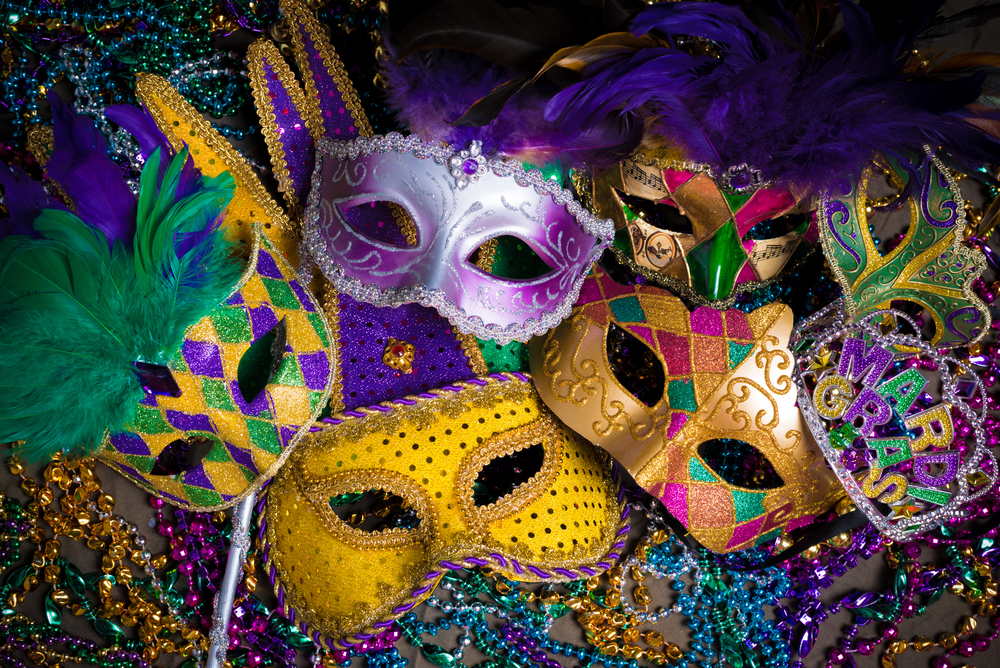Sunday Inspiration: Mardi Gras in New Orleans

“New Orleans is unlike any city in America. Its cultural diversity is woven into the food, the music, the architecture — even the local superstitions. It’s a sensory experience on all levels and there’s a story lurking around every corner.” — Ruta Sepetys
Did you know that Mardi Gras — or Fat Tuesday as it’s often appropriately called — is this Tuesday?
And do you know that my writing career began in New Orleans? It was the perfect place to be a writer because it’s true that “there’s a story lurking around every corner.” I turned many of those stories into books like Iron Lace and Rising Tides and the New Orleans Nights series.
I loved the cultural diversity and the food and music and architecture and especially Mardi Gras, but also the bone deep spirituality in a city not afraid to celebrate religious holidays with joy and abandon. Like everything else about the city, the city’s embrace of different religious traditions is interesting, too. Some of the following is from the Louisiana State Museum’s web pages featuring The Arrival of Religious Diversity.
While New Orleans’ religious origins were Catholic, Protestants began to assert their claims on the city’s spiritual heart after the Louisiana Purchase. They were not alone. Enslaved men and women brought their own African and island religions, voodoo among them.
Jews found a place in the city and in history. The museum says:
Judah Touro, who lived from 1775 to 1854, was a native of Newport, Rhode Island who came to New Orleans on the eve of the Louisiana Purchase. He made a fortune as a merchant, about half of which he gave to various charitable causes and institutions. Although he made significant contributions to Jewish religious institutions and charities, he also gave unstintingly to individuals and institutions affiliated with other faiths. When the Rev. Theodore Clapp was ejected from the Presbyterian Church in 1832, Touro stepped in and paid the mortgage on Clapps’s church building, enabling him to continue his ministry without interruption.
Clapp’s church became the First Congregational Society, (also known as the Stranger’s Church), and I’m proud to say that my husband was a successor of Parson Clapp more than a hundred years later, when he served what is now the First Unitarian Universalist Church of New Orleans.
To be in New Orleans is to have a joyful experience on all levels. So this Tuesday I will celebrate Mardi Gras and my love for New Orleans with King Cake and jambalaya and lots of jazz.
In the meantime, as they say in New Orleans, “Laissez les bons temps rouler.” Let the good times roll.
I love reading about your time in NO, and of course, the books. The city sounds so interesting! Hope to spend a few days there in the future!
Thank you for sharing your ‘story’. I’ve only been to NO once, but totally agree – the best food! Love to start my Sundays with your post. Enjoy Fat Tuesday!
Your books set in New Orleans raise awareness, interest, and intrigue in the Crescen City! Thank you for your contribution to the literary side of a multi faceted and highly unique city!
I loved Iron Lace and Rising Tides!! I have never had the opportunity to go to NO, but would go just for the architecture of the buildings and the food!!! Enjoy your Fat Tuesday!
Exactly a year ago my granddaughter decided out of the blue that she wanted to move to New Orleans. Her mother (in Maryland) and I (in Florida) flew with her for a weekend of apartment hunting. We had a fabulous weekend and ate as much of the famous cuisine as we could. I went back in July for 2 days with her, and the whole family spent Christmas with her. After a year there she has decided to move on, but I am so happy that I was able to enjoy the sounds and tastes of New Orleans again.